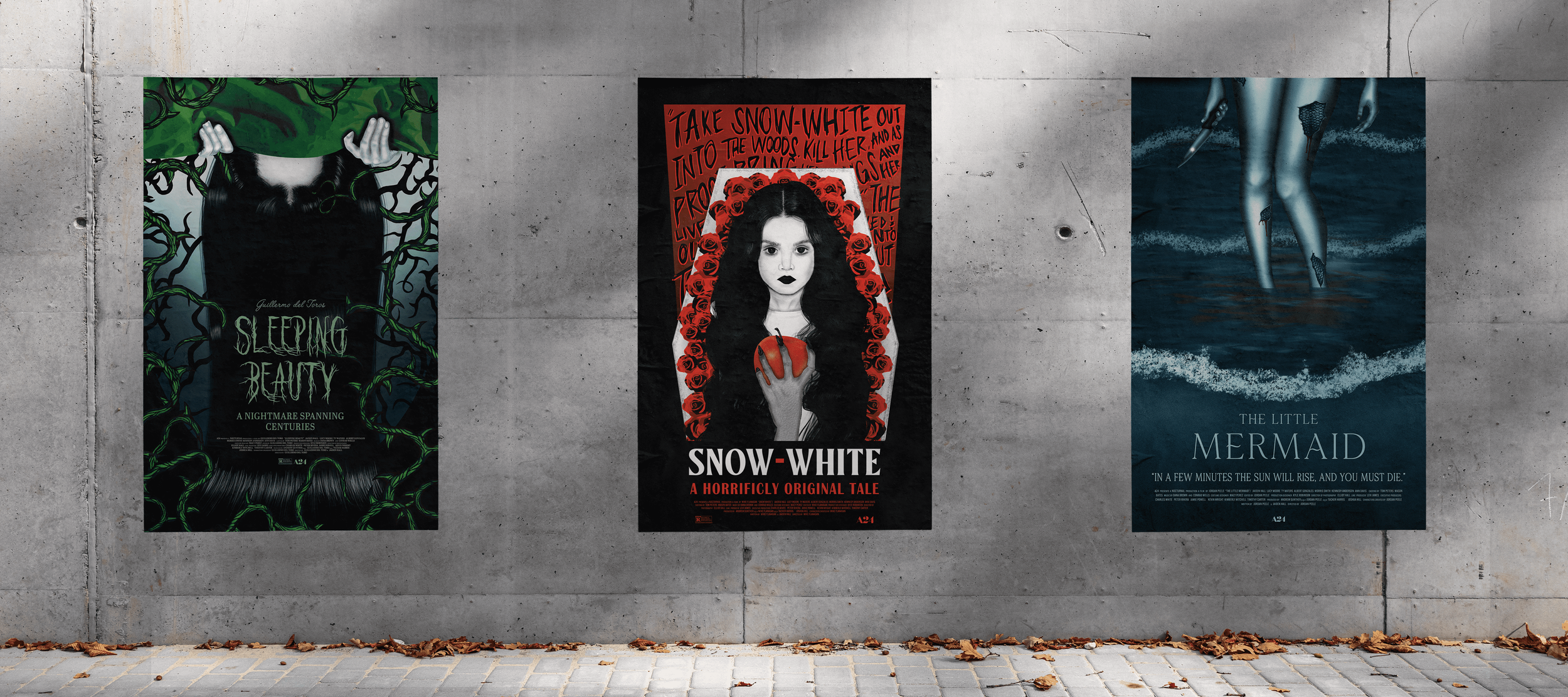
REVAMPING
THE
NARRATIVE
This senior thesis exhibition presents a chilling reimagining of classic fairytales through the lens of horror cinema. Featuring three distinct horror movie posters inspired by the tales "Sleeping Beauty," "The Little Mermaid," and "Snow White"—the exhibition explores the darker, more sinister sides of these beloved stories. In addition to the posters, the exhibition includes specially designed PR boxes for each movie, adding an immersive touch. Each box contains promotional materials including props relevant to each film, and limited-edition prints of the posters. These boxes enhance the overall horror experience, inviting viewers to delve deeper into the reimagining of these classic fairytales.
Giambattista Basile's “Sun, Moon, and Talia” is a 1634 fairytale that inspired most of our modern day “ Sleeping Beauty” adaptations. In the original tale, a very young Princess Talia is spinning flax when a splinter goes under her fingernail, causing her to collapse; seemingly dead. Her body is taken to a forested estate and placed on a velvet throne. Days later,a King stumbles upon her unresponsive body and is so taken by her beauty that he decides to rape her. As a result, Talia eventually gives birth to a set of twins: one girl and one boy, whom she names Sun and Moon. The king's wife finds out about his adulterous activity and orders Talia and her babies to be kidnapped, cooked, and served to her unsuspecting husband. This tale ends with the king saving the trio, and killing the queen instead. Basile’s original fairytale is far removed from any current adaptations of sleeping beauty and touches on many dark subjects such as rape, adultery, infidelity, cannibalism, murder, and helplessness. With my visual reinterpretation I wanted to capture the dark essence of the original tale.
This 1819 Grimm Brothers fairytale follows our protagonist, Snow-White, who runs into trouble when an evil queen marries her father and tries to murder her out of vanity and envy. Snow-Whites stepmother makes three attempts on the innocent 8 years olds life throughout the tale. Her first attempt is suffocation via a lace bodice, her second is stabbing the child with a poisoned hair comb, and finally she tries poisoning her with a tainted apple. The queen’s attempts ultimately fail, and Snow-Whites father tortures and kills his miserable wife out of vengeance. Snow-White tells of an abusive dynamic between a child and their step-parent, with this in mind I aimed to reinterpret the 1812 Grimm Brothers’ tale by portraying the familiar fairytale as a dark horror story. The design captures the sinister elements present in the original tale, amplifying the unsettling themes of innocence, betrayal, and death.
In this 1836 story by Hans Christian Andersen, a little mermaid falls in love with a prince whom she rescued from a sinking ship. Despite the prince having no memory of this, the mermaid desperately wants to meet him again so she visits a sea witch and gives up her tongue in exchange for a potion that will give her legs. The mermaid drinks the potion despite the witch's warning that it will cause her feet to bleed and constantly feel like she's walking on sharp swords. She eventually meets the prince, but soon finds out that he’s already arranged to marry. The little mermaid must kill the prince before his wedding at sunrise, or she’ll die and turn into sea-foam. If she is successful she may return to her family in the water, but the heartbroken princess can’t bring herself to kill the prince. She jumps into the water and her soul ascends to heaven. Anderson’s original tale explores the topics of heartbreak, betrayal, sacrifice, murder, and suicide. The movie poster that I’ve designed is meant to encompass the dread and danger present in Anderson's story, as well as the extreme passion and desperation felt by our protagonist.








